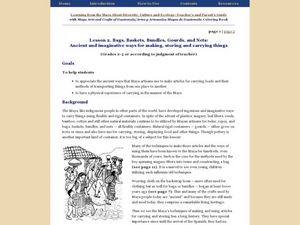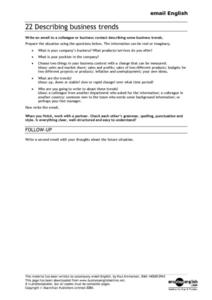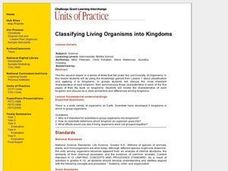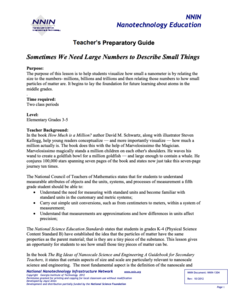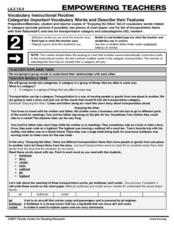Curated OER
Total English Upper Intermediate: Getting Things Done!
In this forming sentences learning exercise, learners unscramble 8 sets of words to form 8 complete sentences. Students use the 8 sentence prompts and use them to describe how often they get or have those things done.
Curated OER
What's Your Thing? Self-Esteem, Peer Support
Students explore their personal strengths. After participating in group discussions, students list verbs that describe their talents. They observe a commercial describing characteristics and talents. Students create their own mini-talent...
Curated OER
Classifying Living Things
In this classification worksheet, students read a description of how all living things are related and describe a diagram showing how this taxonomy works. Students answer five questions related to their reading.
Curated OER
10 Things I Hate about Shakespeare
Students look at the works of Shakespeare to describe and explain relationships among some of the different texts. The writing of the learners has the intent of increasing comprehension, interpretation, and critical analysis skills.
Curated OER
Bags, Baskets, Bundles, Gourds, and Nets: Ancient and Imaginative Ways for Making, Storing, and Carrying Things
Students explore Mayan culture. In this Mayan world cultures lesson, students identify 5 methods by which the Mayan people carried things. Students view several drawings and photographs of these items, then describe how each item was...
Curated OER
Interactions Among Living Things
Students role play predators and prey, classify organisms as predator or prey, and describe factors that affect population growth and size.
Curated OER
The Good Things in Life
In this health worksheet, students fill in a chart describing the good things in life which include favorite people, activities, places to visit, foods, and things that are exciting. They tell how these things make them feel. The article...
Curated OER
My Favorite Things
Fifth graders write a five paragraph informational essay about their favorite things. They correctly use a colon in listing items. Students analyze paragraph writing through questioning. They indent paragraphs, use a colon before a...
Curated OER
The Environment and Interactions of Living Organisms
Students study the environment and interactions of living organisms. They identify abiotic and biotic factors and create a foldable and vocabulary cards. They create a poster illustrating soil and watch a video to study symbiosis.
Curated OER
Every Living Thing
Students read the book "Every Living Thing." They read one story at a time, and participate in various activities. Some of these activities include the following ideas: Students write about a time when they were in a similar situation as...
Curated OER
Describing Business Trends
In this technology worksheet, students write e-mails that are focused upon the concept of describing business trends. The sheet contains some suggestions.
Curated OER
These Are Things in My Community
First graders compare differences within their school community. In this communities lesson, 1st graders tour several classrooms to observe things they see. Students record observations on a handout. Students complete a Venn diagram to...
Curated OER
Writing Paragraphs: Paragraphs which describe events in chronological order
Students explain the structure of a paragraph which describes chronological events. They demonstrate this by construction in writing of a paragraph.
Curated OER
Cells: The Units of Life
In this biology worksheet on cells, 9th graders name who the first person was to use the word cell and describe in what materials this person saw cells. Then they determine what instrument uses light and two or more lenses to view cells.
Curated OER
Classifying Living Organisms into Kingdoms
High schoolers create a flip book that describes the basic characteristics of the five main animal kingdoms. They research the animal kingdoms, include examples of organisms for each kingdom and illustrate the finished text.
Curated OER
Whose Parts Do I Have? (Wings and Things)
Students identify an animal and a body part and then matches a body part to a specific animal. This will assess their ability to sort organisms and objects into groups according to their parts and describe how the groups are formed and...
National Nanotechnology Infrastructure Network
Sometimes We Need Large Numbers to Describe Small Things
String the class along to help them understand large numbers. A multi-disciplinary lesson uses literature, science, and math to look at very large numbers. Pupils conceptualize how much a million is using literature before performing a...
Curated OER
Word Hunt
In this word hunt learning exercise, students make lists of things that . . . are described in phrases. Students name thirty groups of things.
Curated OER
Word Hunt
In this word hunt worksheet, students supply as many words as possible to name things that are described. In this short answer worksheet, students write nouns for thirty descriptions.
Curated OER
What Makes Things Move?
In this movement worksheet, students will describe the effect of 3 specific actions on objects, such as pushing or pulling an object.
Curated OER
Triangles and Things
Young learners listen to the story book The Greedy Triangle as the teacher introduces new polygon shapes. They use geometric stencils to trace a quadrilateral, a pentagon, a hexagon, and an octogon onto a foldable notepad....
Curated OER
Categorize Important Vocabulary Words and Describe their Features
Second graders read a short passage along with the teacher to pull out various transportation related words. They analyze each of the chosen words by creating a chart which helps them think about the similarities and differences of each...
Curated OER
Describe Measurements Step-by-Step Lesson
How do we measure something? As learners are beginning to grasp the idea of a consistent unit of measurement, give them this activity as a warm-up. They see an apple with a column of blocks beside it. Ask them how high the apple is,...
Curated OER
Seeing Things From the Someone Else's Point of View
Students attempt to see the world from someone else's perspective. In this Peace Corps lesson, students read "Sharing in Africa." The piece challenges readers to consider how show respect for the cultural values of others while not...




